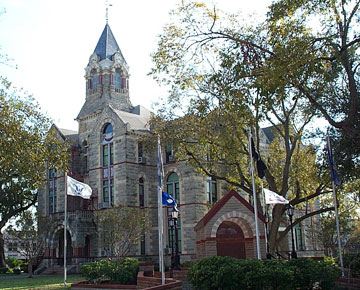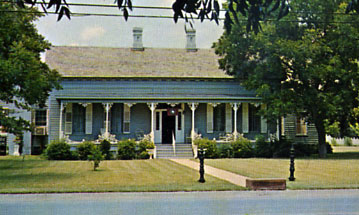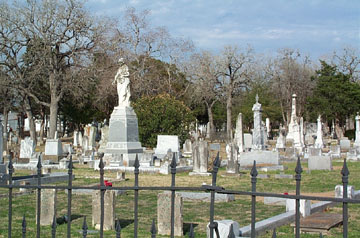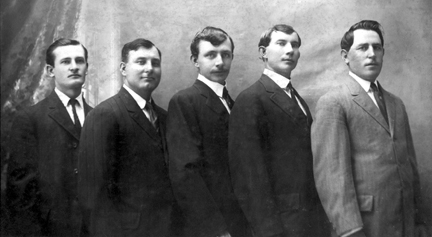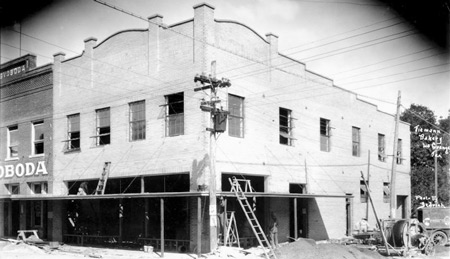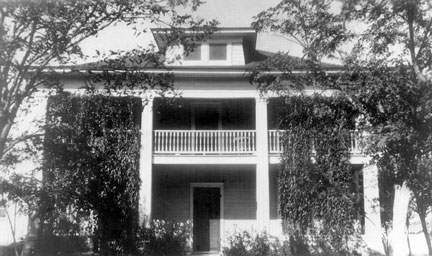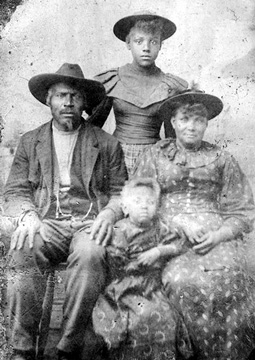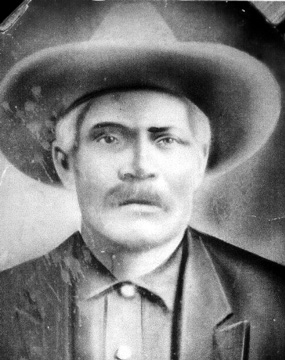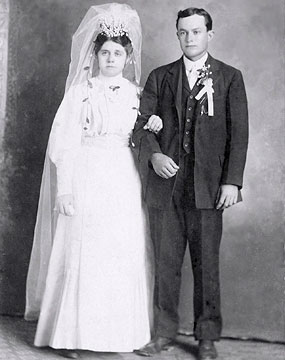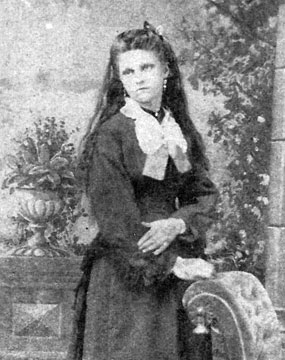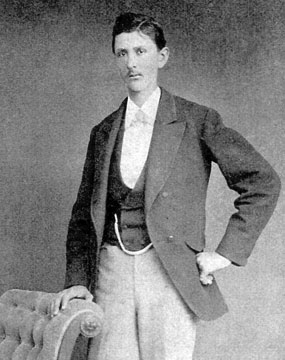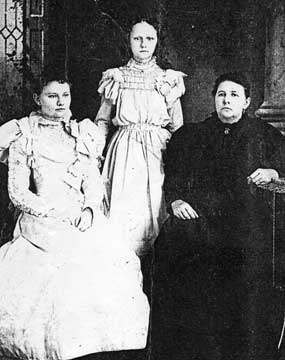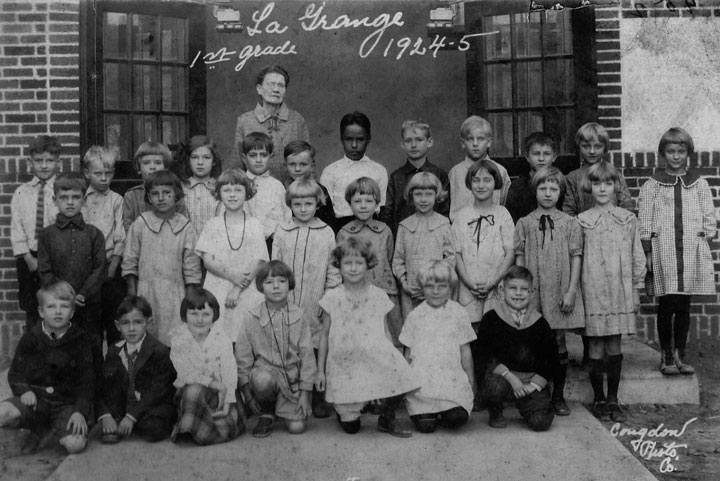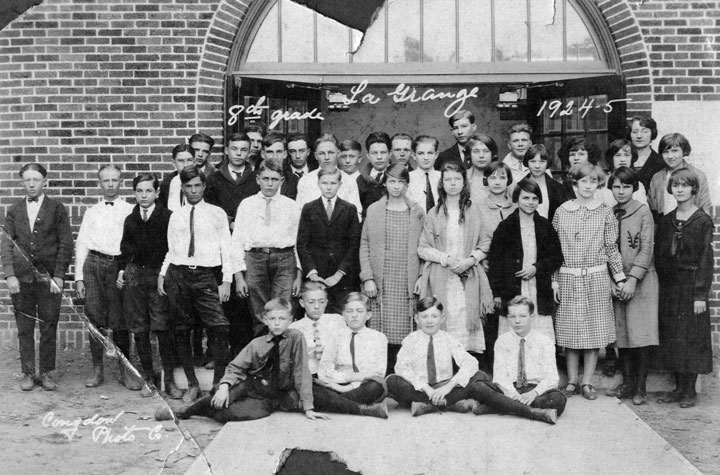Historical Markers
Fayette County Courthouse151 North Washington Street About 1890, the structural safety of Fayette County's third courthouse came into question, and plans began for the building of this structure to serve as the seat of justice for the county. The commissioners court hired San Antonio architect James Riely Gordon (1863-1937) to design the new courthouse and oversee the construction. Gordon, who was 27 years old at the time, went on to become a noted architect of public buildings in Texas. Funding for the 1890-91 courthouse came from the sale of $90,000 in bonds. Martin, Byrnes and Johnston of Colorado City served as building contractors. Gordon designed the courthouse in the Romanesque Revival style and specified four types of native Texas stone to detail the exterior: Blue Muldoon sandstone, Belton White limestone, Pecos Red sandstone and Pink Burnet granite. A central open atrium, designed to promote good lighting and natural ventilation, highlighted the interior space. The extensive use of stone, along with the massive arched windows and doorways, exemplify the building's Romanesque Revival influences. The oldest existing J. Riely Gordon courthouse in Texas, the Fayette County courthouse was completed in 1891. It has served as a setting for social events, celebrations, courtroom dramas and political oratory, and continues as a center of politics and government for the county. Recorded Texas Historic Landmark - 2001 |
|
|
|
The Faison House822 South Jefferson Street Started 1841 as two rooms of local pine wood. Acquired 1855 and enlarged by S. S. Munger. Owned 1866-1961 by estate of N. W. Faison (1817-70), who joined 1842 Dawson expedition resisting Mexican invaders. Captured near San Antonio when many Dawson men were massacred, Faison was later pardoned by Santa Anna. While serving 1843-56 as county clerk, he worked to return bones of his slain comrades for burial on Monument Hill in 1848. [1962] |
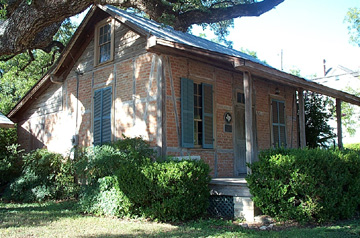 |
City Library Building[The Old La Grange City Library]159 East Fannin Street Erected 1852 as J. C. Stiehl family home; sold to Etairio Club in 1912 and given to city of La Grange in 1938. Architecture is German "fachwerk," using handmade brick and hand-hewn cedar timbers joined with wooden pegs. Restored in 1967-1969. Recorded Texas Historic Landmark - 1970. |
|
|
Old City CemeteryCorner of East Travis & West College Used for burials by 1840, this site was deeded by J. S. Lester to trustees who conveyed it to La Grange after incorporation of the city on July 3, 1854. Fourteen townswomen on April 17, 1873, formed what was probably the first such organization in Texas when they organized the Ladies' Cemetery Association of La Grange. Mrs. L. W. Moore was the first president. Since that time, this association has maintained and administered city cemetery. Annual decoration day, started in 1874, honors those resting here including many of the pioneers who fought for Texas freedom. [1973] |
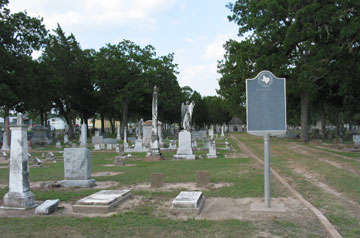 |
Fayette CountyCorner of N. College & E. Travis St., La Grange Formed from Colorado and Bastrop counties. Created December 14, 1837. Organized January 1, 1838. Named in honor of Marquis de LaFayette. 1757-1834. Nobleman and Republican friend of Washington and of the United States. County Seat, La Grange. [1936] |
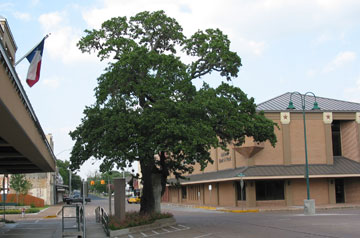 |
The Dawson Expedition/Historic OakCorner of Washington & Colorado It was under this historic oak when the men of Capt. Nicholas Mosby Dawson's company assembled on September 15, 1842 and went to the relief of San Antonio to repel the invasion of Texas by the Mexican Army under Gen. Adrian Woll. In the fight near Salado Creek, September 18, Dawson and 35 of his men were killed, 15 captured and imprisoned in Castle Perote in Mexico, and 3 escaped. Here on the courthouse square, the scarred remains of what was once a mighty oak marks the spot from which La Grange has on every occasion sent its sons to battle. In fights with the Indians, the struggle with Mexico, in the War between the States, the Spanish American War, and in two World Wars, sons of Fayette County were first marshalled under this tree. Wives, mothers, sweethearts here bade farewell and sent their men to battle, each time to win acclaim as true patriots. [1963] |
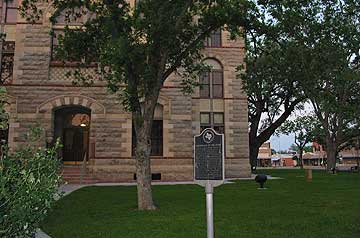 |
Birthplace of the SPJSTSouthwest corner of Courthouse Square On December 28, 1896, twenty-five Czech-Texans gathered in the district courtroom of this courthouse to establish a new fraternal benefit insurance society, the Slovanska Podporujici Jednota Statu Texas, more commonly known a the SPJST. The SPJST held its first convention in the same room on June 20, 1897. I. J. Gallia served as the society's first president and J. R. Kubena was the first secretary. The SPJST officially began its business in Texas on July 1, 1897. SPJST headquarters now is located in Temple. [1983] |
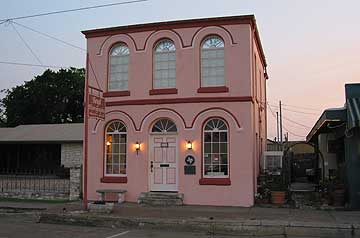 |
Beer and Bottling Company114 South Main Street F. W. Grassmeyer commissioned German-Texan stonemasons to construct this Italianate style commercial building between 1856 and 1859. The structure served as a hotel until 1893, when German immigrant Fritz Presun purchased it as a regional sales office for large American breweries. In 1897 Presun added a bottling operation, The Crown Soda Factory. His son Henry continued the business and also sold oil and gas here. Recorded Texas Historic Landmark – 1983 |
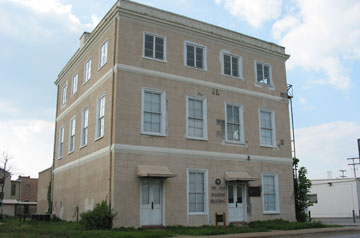 |
The Old Masonic BuildingEast Travis Street Recorded Texas Historic Landmark, 1962 |
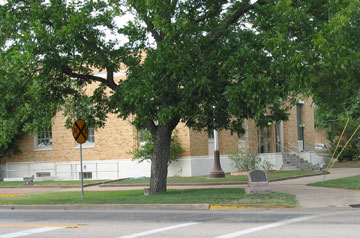 |
The First U. S. Postal Rural Mail Route in TexasCorner of Colorado & Jefferson St., La Grange. Authorized effective August 1, 1899. La Grange, Fayette County. [1936] |
 |
Fayette County, C.S.ACorner of East Travis & North College Streets Although voted 600 against to 580 for secession, began Confederate recruiting in June 1861. La Grange was headquarters for 22nd Brigade, Texas State Troops, Brig. Gen. Wm. G. Webb commanding, of which 18 companies (1,238 men ) and 72 officers were from Fayette. Special county war taxes provided relief for soldiers' families. Funds were also raised by the famous "Cow Order" for seizure of strays. Censors here banned exchanges of mail with the U.S. Confederate cotton gathered in and stored at La Grange and Round Top was freighted to Mexico by local men hauling 5 or more bales on each 3-months-long trip. In 1863 a dozen teamsters lost outfits and barely saved themselves when bandits struck near Roma, on the Mexican border. Gen. Webb and Cols. John C. and Wm.F. Upton were Fayette County men. Local C.S.A. units were commanded by Capts. Ira G. Killough and Ben Shropshire, who fought in the Arizona-New Mexico campaign. Gen. Tom Green, first county surveyor, and Indian fighter and hero of San Jacinto and the Mexican war, had a part in such Confederate victories as the recapture of Galveston and the Battle of Mansfield, La. [1964] |
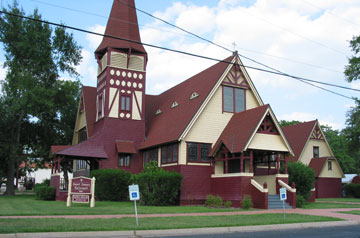 |
St. James Episcopal ChurchCorner of Monroe & Colorado Streets St. James was built in 1885 on land donated in 1867 by the Shropshire family. It has been in continous use as.... |
 |
Site of a Twin Blockhouse385 N. Main Street Built about 1828; used as a place of defense against the Indians and known as Moore's Fort in honor of its builder and owner, John Henry Moore, 1800-1880, noted Indian fighter and commander of the Texans at the Battle of Gonzales, October 2, 1835. The City of La Grange was established May 17, 1831 on his land. [1936] |
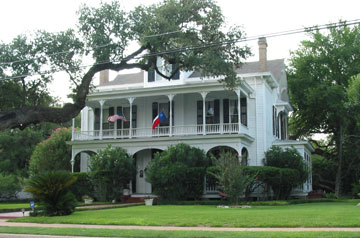 |
Kaulbach Home351 E. Colorado Street Built 1885 by H. B. Kaulbach (1839-1919), insurance agent. The Victorian style exhibits two-story columnar gallery, graceful arches supported by thin, turned columns. This structure includes 5 rooms of house previously on site. Architect was C. Michaelis. Recorded Texas Historic Landmark, 1868. |
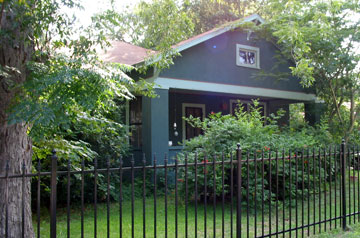 |
W. S. Robson314 North Monroe Street Georgia native William Sion Robson migrated to Texas with his parents in 1852. After settling in Round Top (17 miles NE), the family moved to the La Grange area in 1863. After working as a butcher, Robson served in several public offices, including tax assessor and deputy district clerk. In 1880 he and his wife Lucy (Praetorius) (1854-1922) built the original section of this home. Robson became a lawyer and in 1890 was elected Fayette County Judge, a position he held for three terms. A charter member of Texas Bar Association, he was also active in political and fraternal groups. [1982] |
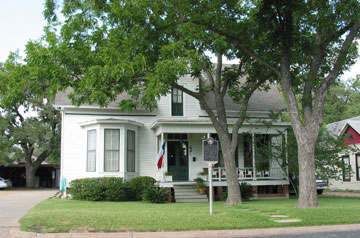 |
Meerscheidt House458 N. Monroe Street Tax records indicate this house was built in 1884, the same year the property was purchased by Paul Meerscheidt from his relative, attorney Axel Meercheidt. German immigrants and prominent local farmers John Speckels, Sr., and his wife Marguerite (Imken) acquired the property in 1890. The house is a fine local example of a late Victorian-era dwelling. Especially fine detailing is evident, including the gable end detail, dormer detail, and decorative geometrical balustrade on the porch. The house was moved slightly to the south of its original location about 1970. Recorded Texas Historic Landmark - 1995 |
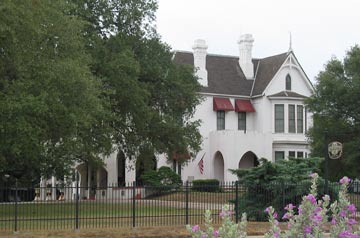 |
Bradshaw-Killough House345 East Travis Street Built in 1886 for local merchant Amzi T. Bradshaw and his wife Sarah, this house was purchased in 1908 by their daughter Nellie and her husband John Killough. In 1924, the Killoughs extensively altered the Victorian-era wood frame residence by adding the Tudor revival style crenelated arched entry portico and side porte cochere. The 2-story bay window and corbelled chimneys are reminders of the structure's original architectural style. Recorded Texas Historic Landmark-1991. |
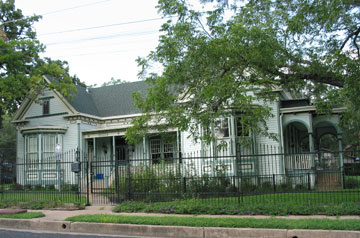 |
Lenert House350 N. Madison Street Albert Charles Lenert (1841-1902) and his wife Amelia (1853-1952), both of whom immigrated to Fayette County from Germany as children, moved to La Grange in 1894 and built this home for their family. A fine example of high Victorian Italianate style, the frame structure features symmetrical front massing, an inset central porch, a side porch with Moorish arcade, and fine milled detail.. The home remained in the Lenert family until 1979. RTHL - 1987 |
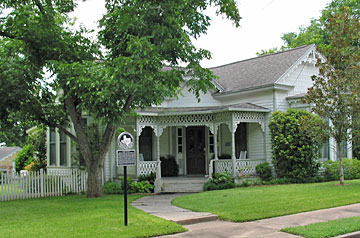 |
Kallus HouseNorth Franklin Street Built in 1885-86, the house became the residence of the Kallus family in 1916. Moravian native Frank J. Kallus (1872-1951) came to Texas in 1890 and later taught school in nearby Ellinger. He married Elizabeth Weisner, and the couple had four children. Two years after her death in 1902, he moved his family to La Grange, where he was a county official and lawyer. The home transferred to daughter Anna Kallus (d. 1995) upon his death. It reflects Gothic Revival styling in projecting bays and ornate details. Features include a corner entry and a separate cellar house. Recorded Texas Historic Landmark - 2004 |
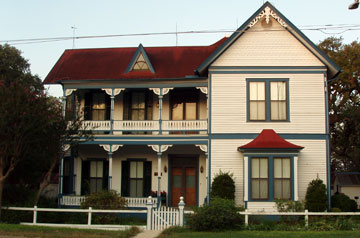
Photo contributed by Marion and Steve Daughtry |
Hermes House541 North Main Street German native Dr. William A. Hermes moved to La Grange in 1855 to practice medicine. He opened Hermes Drug Store the following year with his partner, Dr. Eck. His two sons, August and William, Jr., earned pharmacy degrees and joined the family business. In October 1892, Dr. Hermes gave this house as a wedding gift to William, Jr. and his bride, Augusta Pauline (Willenberg), also a native of La Grange. Here, William, Jr. and Augusta reared two children, Myrta and Gilbert, who also became a pharmacist at the family store. Since the arrival of Dr. Hermes in 1855, the family has played an active and philanthropic role in church and community organizations, and contributed to La Grange businesses, schools and health services. The two story residence was built with second-hand lumber and cypress clapboard siding. The asymmetrical folk Victorian home features a double gallery, ornate fretwork, a decorative vergeboard at the peak of the front gable, bay windows, two-over-two lights, jigsawn porch detailing and vertical massing. The family began constructing additions to the home soon after occupying it in 1892. In effect a city farmstead, the site includes several other vernacular structures, such as a gazebo, an outhouse, buggy house, garage, servant quarters, smokehouse, barns and chickenhouse. Evidence uncovered by family members during restoration work indicates that water from a 1913 flood rose to four feet inside the house. Today, the complex of buildings at this site represents a transition from rural farm life at the turn of the 20th century to city life more than 100 years later. Recorded Texas Historic Landmark – 2004 |
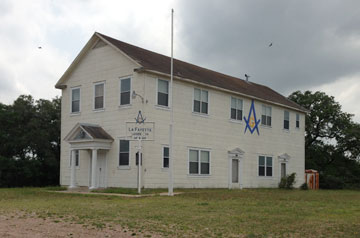 |
La Fayette Masonic Lodge No. 34 A.F. & A. M.La Grange's Masonic Lodge organized in 1847, with John Murchison as the first worshipful master. Historically, Masons have supported many civic causes including education. The La Fayette Lodge laid the cornerstone for the Fayette County courthouse in 1891, with District Judge and lodge member Lyttleton W. Moore delivering the oration. The lodge lost its charter in 1883-84 due to inactivity, but reformed in 1889 with its original lodge number and R. P. Kirk installed as worshipful master. The present lodge temple was dedicated Jun. 22, 1939. Notable members have included Judge Moore, G. A. Stierling, William Loessin, Charles Jungmichel, and many other local and state leaders. - 2012 |
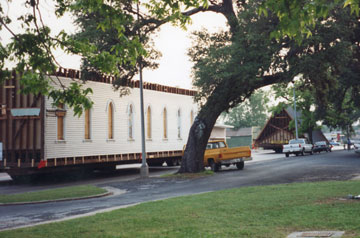 |
Travis Street Methodist ChurchThis lovely old church was located across Travis Street from the Bradshaw-Killough house. Its historical marker was withdrawn in 1998 after the church was moved to Round Top and extensively renovated for use as a recital hall. The text of the marker read: Text of marker from files of Fayette Heritage Museum & Archives
|
